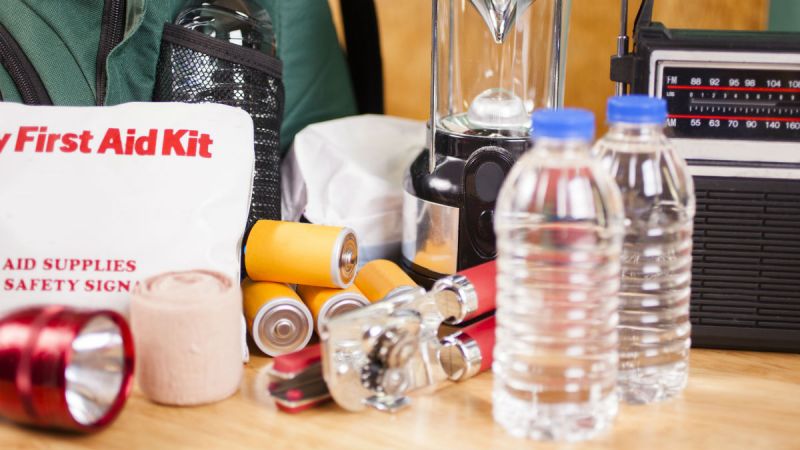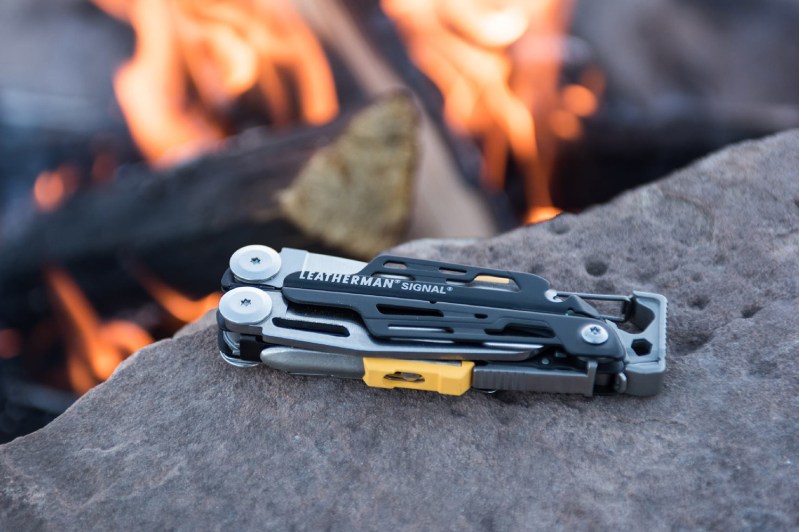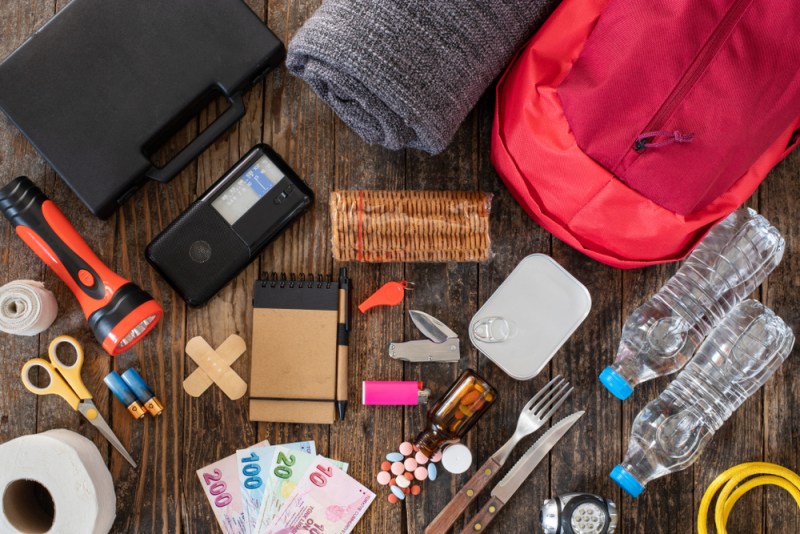
We’ll get into specifics below, but a quick note: This is not a comprehensive guide for assembling a once-and-for-all kit that will help you live on indefinitely after an apocalyptic event. I’m not including a radio, a GPS unit, any sort of defensive gear, a tent or different type of shelter, or other more involved supplies. Rather, this is a guide to help you plan an emergency readiness kit that will help keep you safe for a few days as you wait for civil services to be restored or you travel to an area unaffected by the situation. And while I hope you never experience even a two- or three-day emergency, I advise you to get ready for the possibility by assembling a kit now. You’ll be glad you did in the event, or you else you’ll be really … really sorry you didn’t.
I’ve structured this article as an emergency response gear checklist for clarity and convenience. Now, without further adieu (for who knows when disaster will strike!?), here’s what to include in your basic emergency response kit.
Emergency Kit List
- Water
- Food
- Lighting
- First Aid Kit
- Fire-Starting Supplies
- Protective Gear and Clothing
- Signaling Gear
- Multitool
- Maps
- Personal Emergency Prep Needs
Water

Your body needs water. If you can get through your whole life never truly knowing thirst, you won’t have missed anything, trust me. Without water, your chance of surviving for more than a few days at most is basically zero, especially if you (or anyone depending on you) gets injured. Ideally, you can keep at least two liters per day per person on hand, but anything will help. I recommend you keep a five-gallon jug as well as several smaller containers filled and at the ready; the large jug can be used for cooking, rinsing, and drinking, while the smaller vessels can be ready to roll if you have to bug out. You can opt for pre-packaged emergency drinking water
Beyond water itself, make sure you have some sort of water purification or filtration option on hand. The water you stockpile will run out eventually, and then you will need to source more. A Lifestraw is a great tool for use on the go or in the home, while iodine tablets can also render water safe to drink.
DATREX Emergency Water Pouch
Food

Aka human fuel. Emergency food and camping food are not the same things. Don’t stockpile meals that need to be prepared with boiling water or additional ingredients; instead, stock foods that are ready to eat with no additional prep. You can choose from a host of options including military-style MREs (Meals Ready to Eat) or various survival food options, one of the best of which are The Survival Tabs
Survival Tabs
Lighting

You have to see to survive. If you can’t see what you’re doing, you can’t do much. That holds true for everything from proving first aid to cooking a meal to making your way down an unlit woodland path or city street. Your emergency response kit should have at least two light sources. This is in case one fails, and also because hopefully, you’re not facing this emergency alone.
I strongly recommend one of your lights be a headlamp, with the Black Diamond Storm Headlamp
As for your second source of illumination, a multidirectional lantern is the best bet, with the Coleman Northstar Propane Lantern
You can also just use a couple of good flashlights
Black Diamond Storm Headlamp
Coleman Northstar Propane Lantern
J5 Tactical V1-PRO Flashlight
First Aid Kit

Every home (and body) needs one. Even if you don’t have an emergency prep kit, you still need to have a good first aid kit. You can stop bleeding, treat burns, clean wounds, and help yourself and others, you know, avoid agony.
If you’ve already got a first aid kit you trust, store it in or near your emergency prep kit. If you don’t have one yet, get the Survival Medical On the Move Kit Lite. This carefully curated kit comes with everything you should need to treat all sorts of minor wounds and even more serious trauma, and it has supplies for insect bites, burns, skin afflictions, and more. This and all Survival Medical first aid kits are factory-sealed, so you can count on the contents being in good working order whenever you need them. It’s a great choice for the car campers, the boater, and for other activities.
Swiss Safe 2-in-1 First Aid Kit:
Fire-Starting Supplies

For cooking and warmth. If you live in a cold area or a region that experiences chilly winters, your emergency prep kit needs fire-starting tools and supplies. If you live in an area that’s warm all the time, you still need fire-starting gear. Fire can be used for warmth, sure, but also for purifying water, cooking, lighting, sterilization, and for signaling. (Or for warding off tigers and ghosts.)
Pack some good storm matches spark tool
UCO Stormproof Matches
Zippo Mag Strike
Protective Gear and Clothing

To stay dry and stay warm. Did you know more people get hypothermia while hiking through the mountains in the summer than in the winter? It’s true. And why? Because they weren’t properly prepared, in this case for the extreme temperature drops at night. The same can be true anywhere, though. Even if you live in a warm or mild region, you need to include clothing and/or blankets ponchos are crazy cheap
Grabber – The Original Space Brand Emergency Survival Blanket
Wealers Rain Ponchos
Signaling Gear

Get some attention. Ideally, you will remain in some sort of contact with others even during an emergency situation, whether by landline, cellphone, text or email, or radio. Have a backup charging source for those things to get some extra use out of them. But plan for such systems to falter or fail, and instead keep a signaling mirror whistle
UST StarFlash Micro Signal Mirror
Michael Josh Emergency Survival Whistles
Multitool

The knife/can opener/scissors/etc. First aid often calls for using a blade. Making a fire often requires some sawing. Opening a can of food or a bottle? Well, that takes a can opener and a bottle opener, respectively. For these things and more, a good multitool
TACKLIFE 13-in-1 Multitool
Maps

Because paper needs no battery. If you live in a home you might have to evacuate in the event of an emergency, such as a region prone to fires, tornadoes, flooding, or some other awful mess, then keep some paper maps on hand. Unless you know every square mile of the region by heart, you will be amazed how quickly you become disoriented without the help of Waze or your preferred GPS navigation system. Maps have helped people navigate for millennia, and they can still do it today. Or tomorrow … when disaster strikes!
Personal Emergency Prep Needs

Customize your survival. Your emergency prep kit isn’t going to be identical to mine. Mine includes spare contact lenses, fluid, and an old pair of glasses. Yours might have a backup supply of medicine you or a family member needs. Mine has some cat food. Yours might have dog treats. Mine has snacks I know my son likes (and will soon include infant diapers). Yours might need feminine care supplies. And so on. Don’t pack in every single creature comfort you can think of, but do include the essentials when it comes to hygiene, sanitation, and basic care.
And finally, what should you pack your emergency preparedness supplies into? The ideal option is a waterproof bag that can be easily grabbed and brought on the go. But another fine choice, and the one I use, is a large bucket that fully seals and has a handle. It may not be stylish, and it’s a bit clunky, but my trusty bucket is waterproof, crack- and shatter-resistant, and ready to bug-out or help us bug-in should ever the proverbial whatnot hit the fan.
Why is a DIY Emergency Kit Important?
The reason for taking a DIY approach to an emergency response kit rather than relying on a store-bought version goes beyond the supplies you pack into the kit itself; the mere act of assembling a so-called bug-out bag (or a bug-in bag, if you’re going to shelter in place) forces you to think through the potential issues that will arise and to plan your response. Thus, your mind will be better prepared for calamity should this or that awful scenario arise. Not only will you know everything you have on hand, but you will have chosen it with purpose, readying your brain for its efficient and proper use should the need ever arise.
Editor’s note: Coronavirus, aka the COVID-19 pandemic, has caused a global emergency, according to the World Health Organization. We should all be taking the appropriate measures to stay home, stay safe, and stay healthy. However, that doesn’t mean we’re experiencing personal emergencies. It’s times like these that remind us to be ready in case of a natural disaster, a home fire, or even a lack of basic utilities. This is not the time to hoard supplies. It’s a time to be prepared and look out for your community.
Article originally published by Steven John. Last updated by Nicole Raney.



